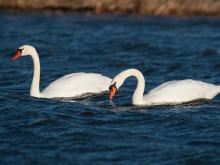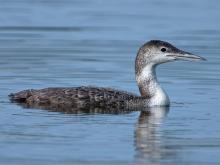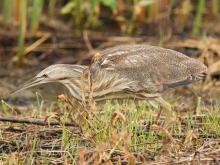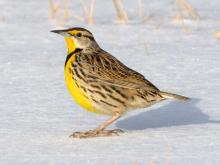Birds
Media

Species Types
Scientific Name
Chroicocephalus philadelphia (formerly Larus philadelphia)
Description
Bonaparte’s gulls are in Missouri during migration and, less commonly, in winter. Breeding adults have black heads. In winter and immatures, the head is white except for a smudgy black spot behind the eye.
Species Types
Scientific Name
Cygnus columbianus
Description
The tundra swan is a rare migrant and winter resident in Missouri. These large, long-necked waterfowl breed far north in the Arctic. In winter, look for them on large bodies of water, wetlands, and agricultural fields.
Media

Species Types
Scientific Name
Cygnus olor
Description
The mute swan is a native of Eurasia that had been transplanted to America. It lives not only in parks and zoos but also, now, in natural habitats. In Missouri, it is seen in winter on rare occasions. Note its arched neck, orange bill, and black forehead knob.
Media

Species Types
Scientific Name
Gavia immer
Description
The common loon, the iconic yodeling bird of northern lakes, may be seen in Missouri during migration and winter. It's less likely we'll see their black-and-white breeding plumage here, but their large size, distinctive shape, and diving behavior helps ID them.
Media

Species Types
Scientific Name
Botaurus lentiginosus
Description
The American bittern is a well-camouflaged, stealthy heron that lives in wetlands, lakes, and ponds. In Missouri, we usually see it in spring and fall. Listen in spring, at predawn or dusk, for its distinctive gulping calls.
Media

Species Types
Scientific Name
Falco peregrinus
Description
The fastest living animal, the peregrine falcon can dive at speeds of up to 261 miles per hour! It is being reintroduced to the state in urban areas, where skyscrapers replace the cliffs it traditionally nested on.
Media

Species Types
Scientific Name
Sturnella magna
Description
In prairies and other open grassy areas, eastern meadowlarks sing sweet, slurring songs from fence posts and power lines. Note the long, sharp bill and the yellow breast with black V-shaped marking.
See Also







Media

Species Types
Scientific Name
Hemaris diffinis
Description
The snowberry clearwing is a moth that confuses people because it looks like a bumblebee and flies like a hummingbird!
Media

Species Types
Scientific Name
Hyles lineata
Description
The white-lined sphinx moth sometimes confuses people because it flies, hovers, and eats from flowers like a hummingbird. The adults often fly during daylight hours as well as in the night and are often found at lights.
Media

Species Types
Scientific Name
Darapsa myron
Description
The Virginia creeper sphinx moth is common in woods and brushy areas and comes to lights at night. The larvae eat Virginia creeper and grape leaves.
Media

Species Types
Scientific Name
Perimyotis subflavus (formerly Pipistrellus subflavus)
Description
Tri-colored bats, formerly called eastern pipistrelles, are relatively small and look pale yellowish or pale reddish brown. The main hairs are dark gray at the base, broadly banded with yellowish brown, and tipped with dark brown.
Media

Species Types
Scientific Name
Myotis grisescens
Description
Gray myotises are difficult to distinguish from other mouse-eared bats. A key identifying feature of the gray myotis is that its wing is attached to the ankle and not at the base of the toes. It’s an endangered species.
Media

Species Types
Scientific Name
Myotis lucifugus
Description
The little brown myotis (little brown bat) is one of our most common bats, but populations are declining. White-nose syndrome has taken a heavy toll in northeastern states. This species is now listed as vulnerable across its range.
Media

Species Types
Scientific Name
Myotis sodalis
Description
The Indiana myotis, or Indiana bat, summers along streams and rivers in north Missouri, raising its young under the bark of certain trees. It is an endangered species.
About Birds in Missouri
About 350 species of birds are likely to be seen in Missouri, though nearly 400 have been recorded within our borders. Most people know a bird when they see one — it has feathers, wings, and a bill. Birds are warm-blooded, and most species can fly. Many migrate hundreds or thousands of miles. Birds lay hard-shelled eggs (often in a nest), and the parents care for the young. Many communicate with songs and calls.





















